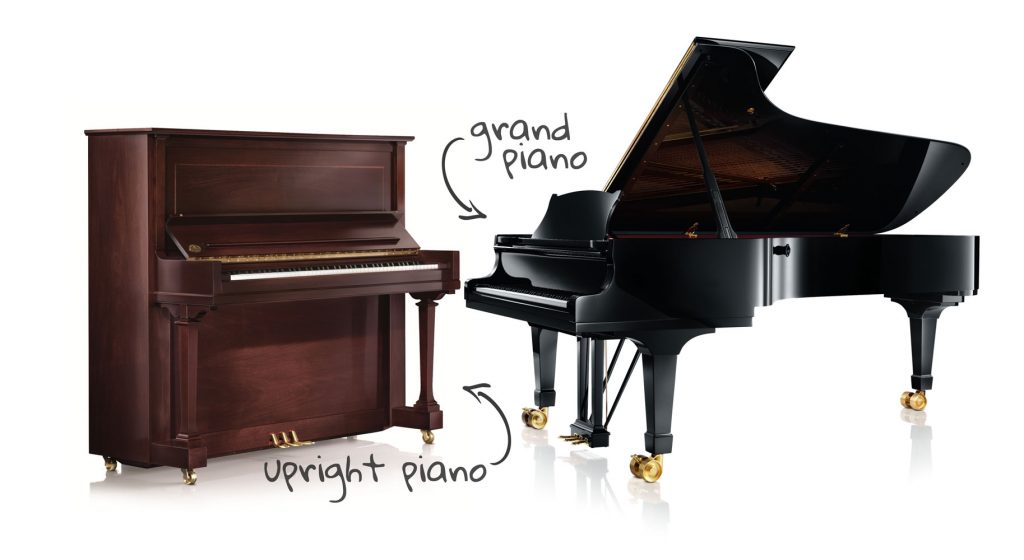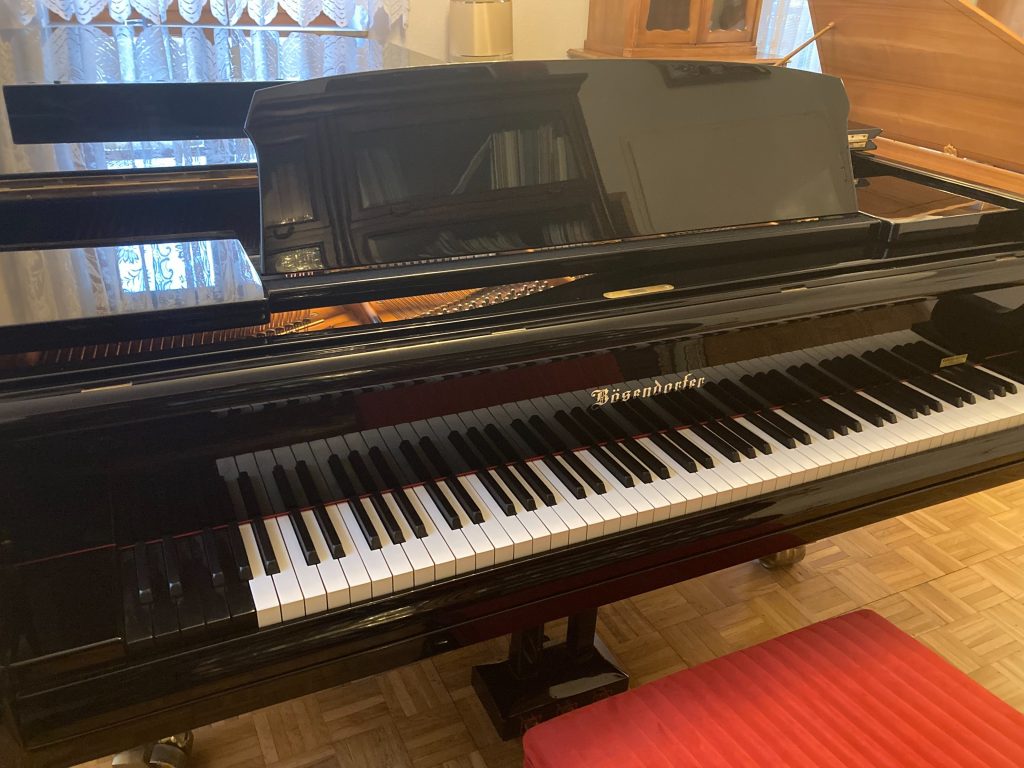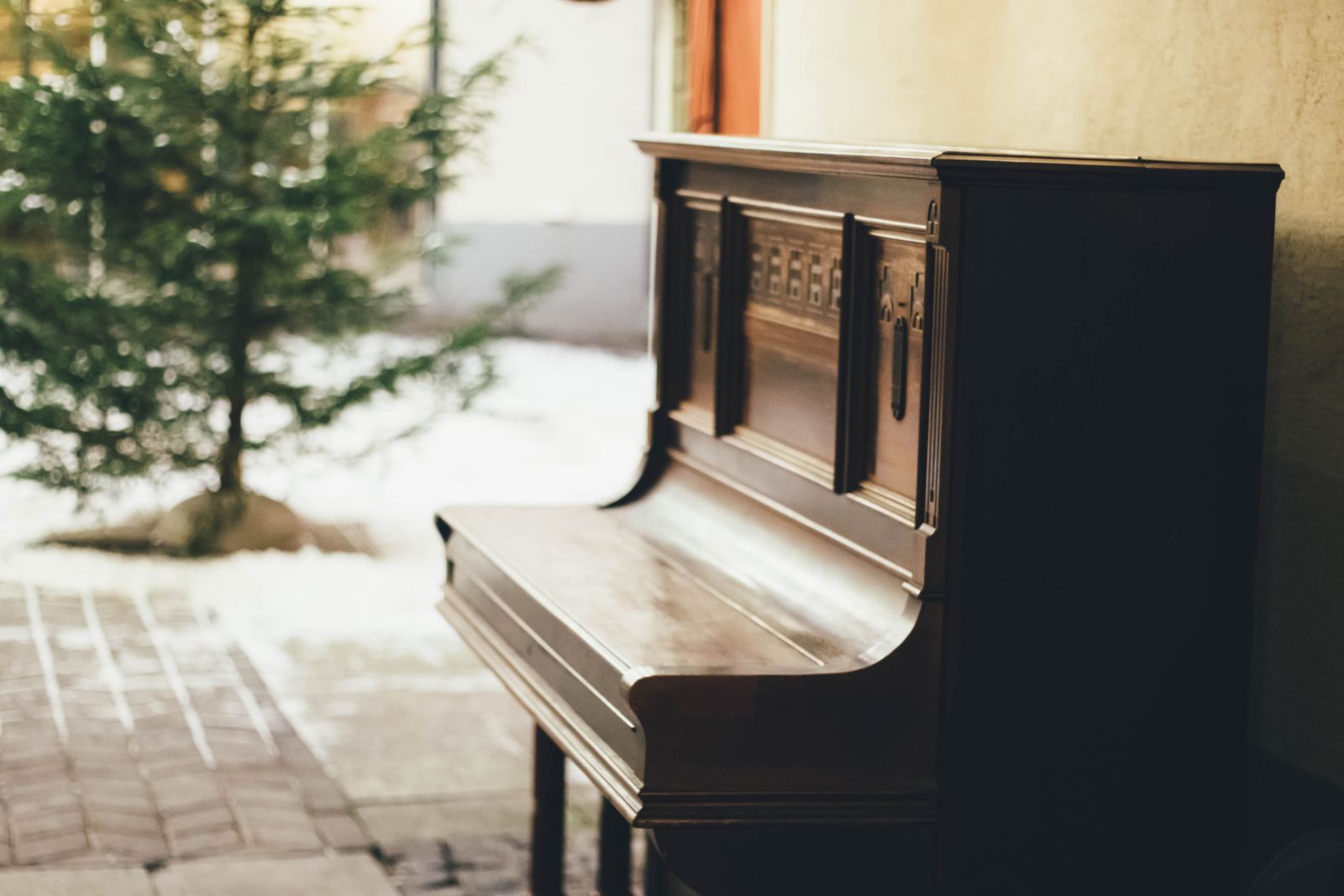When you are looking for an upright or grand piano for sale, you may come across misleading descriptions of the instruments while browsing the advertisements. Sometimes sellers offer a grand piano in the title of the ad. But in reality they are selling an upright piano. Can you say that an upright piano is just a “small grand piano”? What is the difference between an upright and a grand piano? Which of these instruments should I choose?

To distinguish an upright piano from a grand piano, first of all pay attention to the size and shape of the instrument. An upright piano has a vertical orientation. Is not as wide as a grand piano, and the strings are placed perpendicular to the ground. A grand piano, on the other hand, is a horizontally positioned instrument set on three legs.
Which instrument should I buy – Upright or Grand Piano?
Typically, musicians consider a few key aspects when choosing an upright or grand piano – available space, sound quality and budget. One of the most important considerations is the space we can allocate for the instrument. A grand piano, due to its size, requires much more space than an upright piano.
On the one hand, given its construction, a grand piano will not sit directly against a wall but rather in the centre of the room. An upright piano, on the other hand, is always placed against a wall and will fit into a really small space.
Moreover, upright and grand pianos differ in their sound quality. The grand piano, as we have already mentioned, is distinguished by its sound, a loud and momentous sound. This is due to the size of the sound box, which is much larger than in an upright piano. The loudness of the sound can be further amplified by raising the lid. Here, however, it should be remembered that we are writing about a new grand piano, or an older one, but well-kept, restored, of a good brand. An old grand piano with worn-out felt on the hammers and rusty strings will certainly not sound better than a well-kept upright piano.
A final, and often crucial, consideration is the budget we can allocate to the purchase of the instrument. For young student pianists, with a smaller budget and limited space, the most appropriate choice would be an upright piano. A grand piano is a more expensive instrument, considered to be more exclusive. It is also the target instrument for professional pianists and concert musicians. Of course, it may be the case that an upright piano is better value than a grand piano. For example when comparing a new upright piano and an older, unrestored grand piano.
If you want to know exactly what to look for when buying your piano, read our article in which we explain in detail how to choose the right instrument.
I have a lot of space and I dream about a grand piano, but I don’t have a big enough budget for an exclusive piano. What should I do?
You are probably wondering if you are “doomed” to buy an upright piano in this case? There is another solution – you can look for a grand piano available at a lower budget. Do you mean to find an old, cheap grand piano that will sound bad and look uninteresting, and will need repairs in the near future? Absolutely not!

Piano manufacturers have recognised the desire to buy a grand piano among highly talented but less affluent individuals. Some brands have chosen to produce additional lines of grand pianos. Maintaining high standards but reducing production costs (and often relocating factories).
An example of this is Steinway & Sons, who have offered beginner and intermediate grand piano lines – Essex and Boston. Other companies that have decided on such a solution are e.g. C. Bechstein – the W. Hoffmann line or Seiler.
If you are still unsure about which offers to look out for – please contact us.
And what exactly is the difference between a grand piano and an upright piano? Here are a few technical points.

Grand piano
A modern grand piano usually has 88 keys and a scale starting at the A2 sound. In concert pianos, the scale starts at F2, and in much older grand pianos, the scale starts at C1 – C5. Interestingly, a grand piano produced by Bösendorfer, the Model 290 Imperial, has 8 octaves and as many as 97 keys.

In a grand piano, the strings are stretched horizontally on a steel frame. When a key is pressed, the hammer strikes the strings. And the dynamics of the strike are transferred to the strings. Once struck, it immediately bounces back. And depending on the force of the strike, stops at a greater or lesser distance from the strings. This allows for fast repetition, i.e. the same sound can be repeated several times at a fast rate.
We can also differentiate grand pianos according to their length (measured from the beginning of the keyboard to the end of the sound box). An entry-level cabinet grand piano is 140-160 cm long. A salon grand piano is 160-210 cm long. A semi-grand piano is 210-240 cm long and a concert piano is longer than 240 cm. The longest grand piano in the world is the 308 cm long Fazioli brand instrument. To find out more about the different types, read our article “Types of upright and grand pianos”.
There are usually three pedals placed in grand pianos, which are used to change the characteristics of the sound.
- Forte pedal – the right pedal, the most important and the most used. Pressing the right pedal raises all the dampers of the instrument at the same time. So that the sound continues after the key is released. The forte pedal allows you to sustain the desired sounds and release your hands at the same time, so you can play more notes.
- Piano pedal – a left hand pedal that changes the sound to a softer and quieter tone by muffling it. Pressing the piano pedal moves the whole mechanism (including the keyboard) a little to the right. So that the hammers hit fewer strings (2 out of 3).
- Sostenuto pedal – a middle pedal that is usually found in more expensive grand piano models. This pedal is rarely used, and is used to stop damping the currently pressed keys.
Upright piano
The popularity of the upright piano came in the second half of the 19th century. When there was not enough room for grand pianos in middle-class homes. Upright pianos were not only more affordable, but were also smaller and could easily fit into limited space.

As in the grand piano, in the upright piano the pedals are used to change the sound characteristics. Most upright pianos have two pedals. Although in some older instruments, and nowadays in newer upright pianos, three pedals are fitted. The most commonly used is the right forte pedal. Whose task is to extend the sound of the played notes when the fingers are removed from the keys, exactly as in a grand piano.
However, the middle upright piano pedal has a completely different purpose. It makes the sound of the upright piano as quiet as possible. When it is pressed, a strip of felt is inserted between the hammers and the strings. Which reduces the force of the hammer hitting the strings. Interestingly, in pre-war upright pianos, instead of the middle pedal, a knob on the side of the keyboard with the inscription ‘moderator’ was installed. Lastly, using the left pedal (piano) in an upright piano causes a slight muting. When pressed, the resting bar of the hammers moves towards the strings reducing the distance of the hammer from the string.


